Building literacy at home is all about having fun! It requires no special tools or specific activities. All it requires is you, interacting and playing with your child in ways that encourage conversation. The truth is that children learn best not by being “taught”, but by having enjoyable interactions with the important people in their lives.
There’s so much you can do to encourage your child’s early literacy development during the everyday activities you already do together. Use the tips and resources below to get started.
Tips
Build your child’s critical thinking
To truly understand the stories they hear, children need to use their critical thinking skills. These are skills like problem-solving, predicting, explaining and evaluating, and they are what allow your child to “read between the lines” to figure things out that are not actually stated in the book. Encouraging this kind of thinking early in your child’s life will prepare her for understanding the books she’ll read on her own later.
Here are some tips or promoting the E’s and P’s of critical thinking: Explain, Evaluate, Predict, Project and Problem-solve:
Explain
Talk to children about why things happen and encourage them to draw on their existing knowledge and reasoning skills to come up with explanations, as well as the reasons for their conclusions. |
| While pretending with stuffed animals, join in with your own animal and have your animal ask the other a question that could have many fun explanations. For example, "Why is your fur purple?" or "Why do you have such big teeth?" |
Evaluate
Encourage children to offer opinions about their own preferences and the relative merits of different objects, events and experiences. |
| Using plastic food items, pretend you are judges in a food competition. Start by offering your own opinion with an explanation. For example, "I don't like this pasta because it's too salty" or "I like this soup because it has lots of carrots and they're my favourite." Encourage your child to offer his own opinions along with his reasons for them. |
Predict
Make comments and ask questions that encourage children to make plausible predictions about what will happen next. |
| When finished reading a book, encourage your child to think about what might happen next if the story continued. For example, "What do you think will happen tomorrow night when it is time for Mortimer to go to sleep again?" Ask your child to explain why he thinks that. |
Project
Encourage children to project or put themselves into other’s minds with questions like, “How do you think he feels?”, “What do you think she’s thinking right now?” or “Why do you think he wants to do that?” |
| During pretend activities, take on a role and make comments that show your child that you're thinking about how your pretend character feels. For example, "I'm just a little teddy bear in this big department store all by myself. I feel really scared." |
Problem-solve
Take advantage of daily opportunities to encourage children to solve problems. Help the children to describe the problem and draw on their knowledge and experiences as they think of alternative solutions and decide on the best option. |
| Draw your child's attention to problems as they arise and provide her with opportunities to think of solutions. For example, "Uh-oh. Your lunch bag is missing. What else can we use to carry your lunch?" |
Read more about critical thinking
Build your child’s vocabulary
Studies show that the larger a child’s vocabulary in preschool, the better their reading comprehension will be later on.
The secret to building your child’s vocabulary? Shoot for the SSTaRS! Click the button below for a handout you can print to help build your child’s vocabulary:
Build your child’s print knowledge
Before your child can learn to read or write, there are many things she needs to understand about print. Use the arrows to scroll through the slides below for ideas on how to build your child’s print knowledge during everyday routines and activities.
Print knowledge your child needs to learn
Before your child can learn to read or write, there are many things she needs to understand about print. For example, she’ll need to know that:
• Print has meaning
• Print represents spoken language
• Books are used in specific ways (for example, they are held right side up and read from front to back)
• Print is read is a specific order – we read from left to right and from top to bottom
• Print includes letters, words, spaces and punctuation marks
• Letters of the alphabet combine to make words
• Letters have names, as well as upper case and lower case forms
• Words are separated by spaces
• Words are combined to make up sentences
The understanding of how print works is called print knowledge and it’s one of the critical early literacy skills your child needs to be prepared for school.
It’s easier than you think
You don’t need any special tools or activities to build your child’s print knowledge. Simply by talking about the print in your child’s environment, you can do so much to encourage your child’s learning.
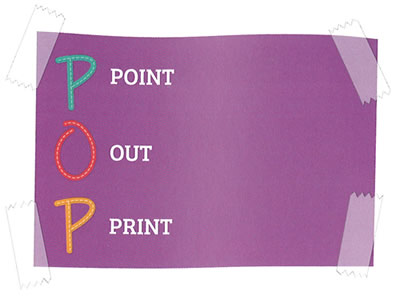 POP – Point Out Print
POP – Point Out Print
It’s not enough for your child to just see print around her. To learn how print works, she’ll need you to
draw her attention to it.
POP is a strategy you can use during any daily routine or activity to draw different aspects of print to your child’s attention. The more you POP, the more opportunities your child will have to think and talk about print.
POP during book reading...
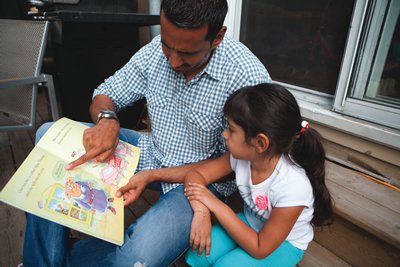
Here are some ways you can Point Out Print during book reading.
(
It’s best to do only 2 or 3 of these things during one reading so you don’t overwhelm your child or interrupt the story too much.)
• Point out the title, author and illustrator of the book.
• Show how we read from left to right on the page.
• Explain that print in speech balloons tells us what the character is saying.
• Explain that illustrations show us what’s happening in the story.
• By tracking with your finger, show that the words being read match the words on the page, with spaces in between.
• Explain how letters work – say the names of letters, especially the first letter in a word, and point out some upper-case letters.
POP throughout the day...
As you go about your day together, opportunities to POP will be everywhere. Here are just a few ideas:
• Breakfast – Point out the colourful letters on the front of a cereal box or a carton of milk.
• Getting dressed or folding laundry – If your child has clothing with print on it, read the print while tracking the words with your finger.
• Bath-time – On a shampoo or bubble bath bottle, find a word that begins with the same letter as your child’s name. For example: “That word says ‘soft.’ ‘Soft’ begins with the letter S, just like your name – Sarah.”
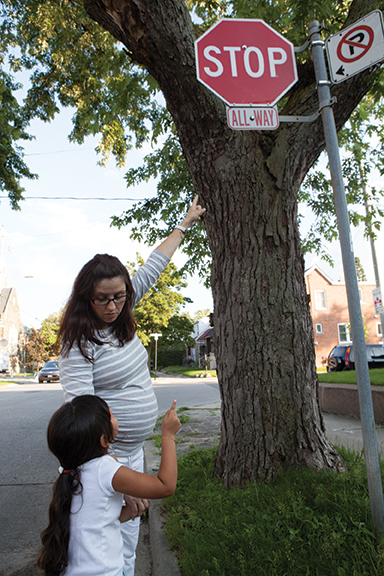 POP throughout the day con’t
POP throughout the day con’t
• Grocery shopping – Encourage your child to find the names of foods on their packages. Read the words and name some letters in the words, or ask your child to name the letters. For example, you can say: “Look, this says ‘butter.’ What letter does ‘butter’ start with?”
• On a walk – Talk about the print you see on billboards, store signs, street signs, vehicles and posters. Make a game of spotting print all around you.
You can also look for signs with more than one word, like “No Parking,” “Main Floor” or “Garage Sale.” Point out the spaces between words and count the number of words on each sign.
Tips on making the most of print
• Choose print that connects with your child’s interests. For example, if she is interested in outer space, point out books or newspaper articles about space, or draw a picture of all the planets together and write out the names for her.
• Put print at your child’s eye level. For example, if you’ve created a sign for a door, place it lower down on the door so she can see it easily.
• “Switch up” the print. Change the print around your house regularly so your child will notice. For example, change the notes you put on the fridge, the posters you put on the walls or the magazines you might look at together.
• Use large print that your child can easily see.
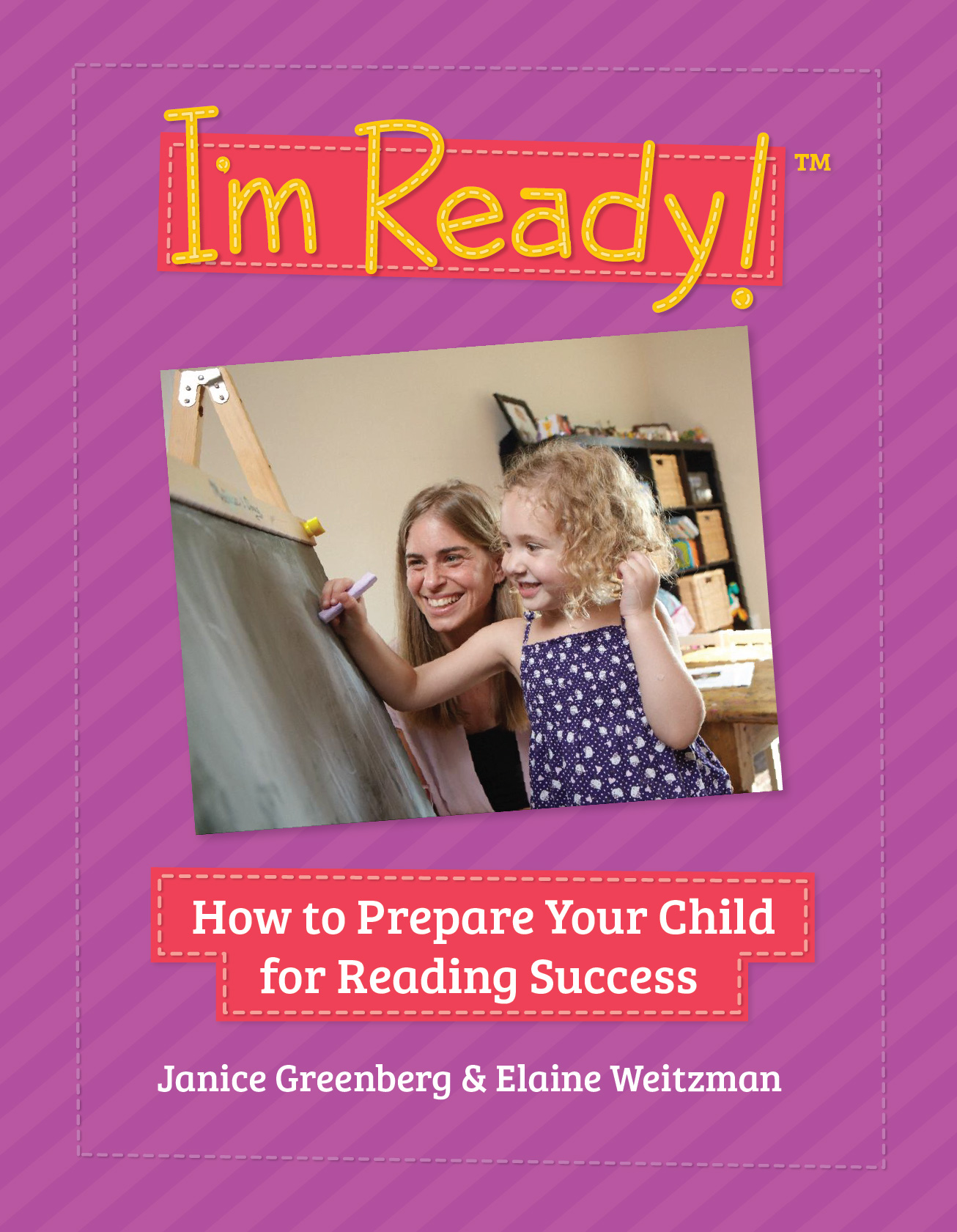 More info and fun ideas for building your child’s early literacy skills
More info and fun ideas for building your child’s early literacy skills
Print knowledge is just one of the many early literacy skills your child needs to be prepared for school.
The tips you read here are from the new Hanen guidebook
I’m Ready!™ How to Prepare Your Child for Reading Success. This practical guide shows you simple ways to promote the key building blocks of early literacy during everyday routines and activities.
Learn more about I’m Ready!
Resources
Language and Literacy Tip Sheets
Download fun, research-based tip sheets to promote your child’s early language and literacy skills during the everyday activities you already do together.
Book Reading Checklist
Print off this checklist to see how you’ve been sharing books with your child and what other things you might do to maximize your child’s learning.
Hanen Book Nook
Get fun tips for using popular children's books to build your child's early literacy skills.
|
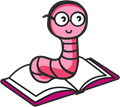
|
"I’m Ready! How to Prepare Your Child for Reading Success"
Use this comprehensive guidebook to learn research-based interaction strategies for building all of the key skills that prepare your child for literacy success.
|
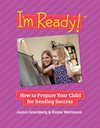 |
Articles
Choosing a Preschool That Encourages Language Learning: What Should You Look For?
Early childhood educators play an important role in building the early language skills that prepare young children for kindergarten. Here are some tips for what to look out for when choosing a preschool for your child.
Read article
Five Books, Five Literacy-Building Ideas!
Early literacy skills are the “tools” your child needs to learn to read and write, so the more early literacy skills she has now, the better prepared she’ll be for school. Here are some fun tips for building the five critical early literacy skills your child needs to learn before she starts school.
Read article
More Than ABCs: Building the Critical Thinking Skills Your Child Needs for Literacy Success
To truly understand a story, your child needs to go beyond the words and pictures on the page and use her critical thinking skills. Find out how you can promote your child's understanding during book reading with "E's and P's" — the building blocks of critical thinking.
Read article
Getting Ready to Read: Building Early Literacy into Daily Activities
Did you know that your child’s journey toward literacy starts long before she begins to read and write? In fact, by the time your child starts school, she’ll need a solid foundation of several “early literacy skills” – the building blocks for learning to read and write successfully. Find out what you can start doing right now to build these critical skills and prepare your child for reading success.
Read article
A is for Apple: What Kids Can Learn in the Grocery Store
While grocery shopping with children can sometimes be stressful, there are ways of turning this regular outing into an opportunity for interaction, conversation, and fun! Find out how you can make the most of this time with your child to encourage her to use and learn language.
Read article
Which Books Are Best: How the Type of Book Affects Children’s Language Learning
Can electronic books promote language and literacy as well as paper books? Do moving parts in a book help children learn or are they distracting? Do the types of pictures in a book affect what a child learns? Find out what the research says.
Read article
Programs
Hanen I'm Ready!™ Program for Building Early Literacy in the Home
Learn how to prepare your child for school by building the essential early literacy skills that are linked to academic success.